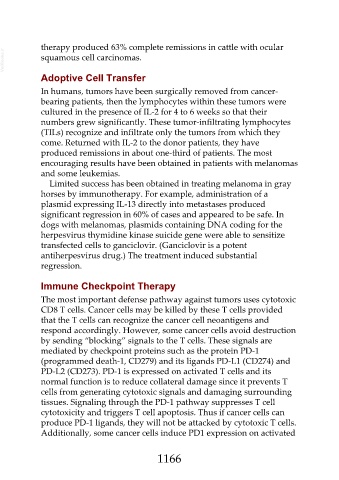Page 1166 - Veterinary Immunology, 10th Edition
P. 1166
therapy produced 63% complete remissions in cattle with ocular
VetBooks.ir squamous cell carcinomas.
Adoptive Cell Transfer
In humans, tumors have been surgically removed from cancer-
bearing patients, then the lymphocytes within these tumors were
cultured in the presence of IL-2 for 4 to 6 weeks so that their
numbers grew significantly. These tumor-infiltrating lymphocytes
(TILs) recognize and infiltrate only the tumors from which they
come. Returned with IL-2 to the donor patients, they have
produced remissions in about one-third of patients. The most
encouraging results have been obtained in patients with melanomas
and some leukemias.
Limited success has been obtained in treating melanoma in gray
horses by immunotherapy. For example, administration of a
plasmid expressing IL-13 directly into metastases produced
significant regression in 60% of cases and appeared to be safe. In
dogs with melanomas, plasmids containing DNA coding for the
herpesvirus thymidine kinase suicide gene were able to sensitize
transfected cells to ganciclovir. (Ganciclovir is a potent
antiherpesvirus drug.) The treatment induced substantial
regression.
Immune Checkpoint Therapy
The most important defense pathway against tumors uses cytotoxic
CD8 T cells. Cancer cells may be killed by these T cells provided
that the T cells can recognize the cancer cell neoantigens and
respond accordingly. However, some cancer cells avoid destruction
by sending “blocking” signals to the T cells. These signals are
mediated by checkpoint proteins such as the protein PD-1
(programmed death-1, CD279) and its ligands PD-L1 (CD274) and
PD-L2 (CD273). PD-1 is expressed on activated T cells and its
normal function is to reduce collateral damage since it prevents T
cells from generating cytotoxic signals and damaging surrounding
tissues. Signaling through the PD-1 pathway suppresses T cell
cytotoxicity and triggers T cell apoptosis. Thus if cancer cells can
produce PD-1 ligands, they will not be attacked by cytotoxic T cells.
Additionally, some cancer cells induce PD1 expression on activated
1166

